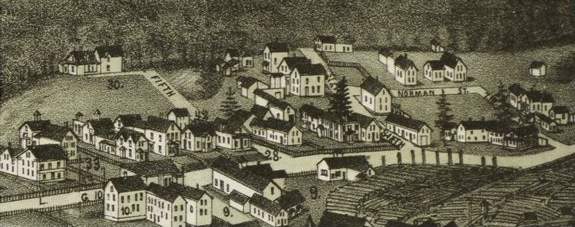
Norway, Sweden, Denmark, Finland, Iceland, Viking, 7th through 11th Streets and adjacent portion of Main Street
Scandinavians, and more specifically Norwegians, were one of the first immigrant groups to come to Berlin. After French and English immigrants from Canada, they were also one of the City’s largest ethnic groups. Their neighborhood, Norwegian Village, grew up where the early Norwegian immigrants worked and chose to live.
Norwegians first appear in Berlin’s 1860 census. At that time there were three Norwegian families living in Berlin, two of which (the John Tillotson family and the Carl Olesen family) were saw mill workers. These and most of the other early Norwegians were associated with H. Winslow & Co. (later the Berlin Mills Co.) as sawyers or in some cases as river drivers. The Winslow Mill was located nearly adjacent to where Norwegian Village is today.
The 1861 Walling Map of Berlin Falls shows the Olesen, Oswald and Gilson (not listed on the Census but also Norwegian) families clustered on the river at the north end of Berlin, adjacent to the Winslow saw mill. Their houses are shown on the east side of Main Street, likely in the yard of the mill.
In 1880, Berlin Mills platted Fifth, Sixth, and Seventh Streets on the block from Main to (what would be) Norway Street, the block of Norway Street between Fifth and Seventh, and lots on the west side of Main for a distance north of Seventh. According to Berlin Mills corporate records, the Oleson and Oswell families purchased lots on Main Street from the company in 1888. By the 1892 map, these families are shown at various locations on the non-river side of Main Street.
City Reports indicate that by 1893, the street west of Main (unmarked on the 1892 Map) was already being referred to as “Norwegian Street” (today Norway Street); at that time a light was installed at the corner of Norway and 5th.

Berlin Mills Village in 1892 – Note the multiple Oleson, Johnson, Ericson, and Halvorson, families all of whom were Scandinavian the Lutheran Church. (Hurd 1892)
By the 1880s, there was a large enough population in Norwegian Village to support a church. St Paul’s Lutheran Church was organized in 1887 with 150 members. On August 31, 1889 the cornerstone was laid for the current church building (NE corner of Norway and Seventh). The church had its first service in May 1895. A parsonage was built in 1900 (44 7th Street), and a
Sunday school wing was added to the church c. 1904-5. Services were held in Norwegian until 1943 and the basement held a 1000-volume Norwegian library. A second neighborhood church, the Norwegian Methodist Church, was built on Sweden Street near 8th (169 Sweden Street)(demolished) in November 1900. The Rev. G. N. Ghundersen was the leader of the congregation.
In 1896, “Addition No. 2 to Berlin Mills Village” was platted and the streets paralleling the river were officially named for the home countries of the existing occupants of the neighborhood. The subdivision ran north from 5th to 11th Street and included portions of Norway, Sweden, Denmark and Finland Streets. The plat excluded lots on both side of Norway Street between 5th and 9th because these were already sold and/or occupied.
 |
By 1900 Norwegian Village, occupied by Norwegians, Swedes and some Finns and Danes, was burgeoning. Although a portion of the Norwegian and Scandinavian community had moved across the river to Hutchins Street, the rest of the community remained clustered in Norwegian Village. An overwhelming majority of the Scandinavians in Berlin around the turn of the century continued to be associated with the saw mill. Many of the Scandinavians, (and other nationalities) located close to the river at the northern end of Berlin were log drivers. There were also a handful of carpenters and house painters and a number of Scandinavians who worked as firemen in the mills.

Class of 1909 at the Brown School in Norwegian Village. The first school serving Norwegian Village was constructed in the 1870s, the current brick school was built in 1913. Notice the predominance of Scandinavian names (BCB 3/1930 p.16).
In 1910, possibly at the peak, there were 269 Norwegian immigrants— 5.3% of Berlin’s population. The same year there were 50 immigrants from Sweden, 11 immigrants from Denmark, and 15 Finns.
Unlike many parts of Berlin, Norwegian Village today consists largely of single-family dwellings. Most of the earliest (pre-1900) houses are simple gable fronts. The area is characterized by late 19th and early 20th architectural forms including gable fronts, bungalows, and four-squares.






 Follow
Follow